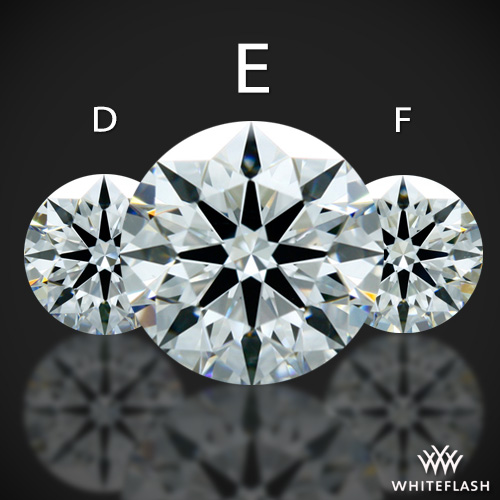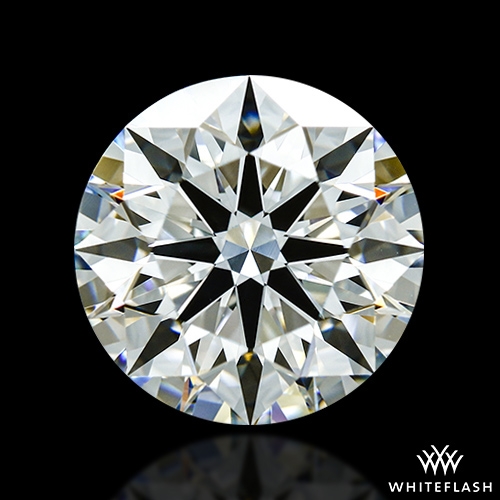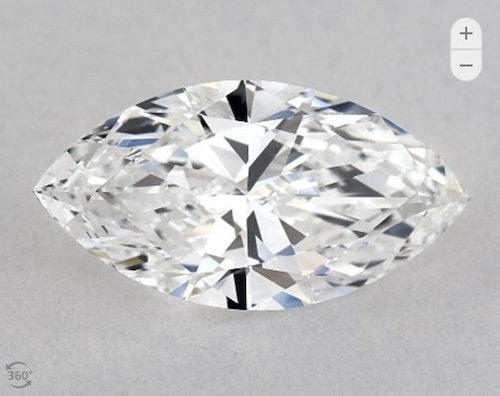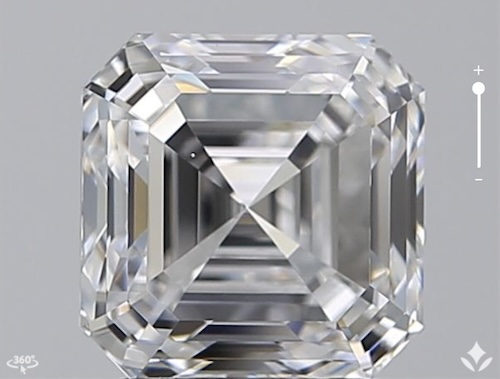Diamond Education
E Color Diamonds
ese diamonds offer an exquisite blend of luxury and affordability. In this guide, we'll delve into the nuances of E color diamonds, unpacking their unique attributes and their place in the world of gemology. Whether you're a connoisseur or a curious buyer, understanding the allure of E color diamonds is key to appreciating their timeless charm.
Summary:
- Understanding E Diamond Color
- E Color Diamonds: An In-depth Look
- E Coler Diamond Grading Process
- Comparative Analysis: D vs. E Color Diamonds
- Natural E Color Diamonds vs. Lab-Grown E Color Diamonds
- Where to Buy E Color Diamonds
Understanding E Color Diamonds
Diamond color grading is central to determining a diamond's quality and value. Let's break it down:
Color Grading Spectrum: Diamonds are graded from D to Z, with D being completely colorless and Z having noticeable yellow or brown tints.
- D-F: Colorless
- G-J: Near-colorless
- K-M: Faint
- N-R: Very light
- S-Z: Light
E Color Placement: E color diamonds are the second grade in the spectrum, making them almost colorless. Their minute traces of color are typically undetectable to the untrained eye, especially when set in jewelry.
Significance: The color of a diamond can impact its:
- Brilliance: How well the diamond reflects light.
- Value: Diamonds closer to the colorless range tend to be more valuable.
- Desirability: Personal preference plays a role; some buyers may prefer the warmer hues of lower graded diamonds, while others seek the pristine quality of higher grades like E.
Understanding the intricacies of diamond color ensures a more informed purchasing decision, as color interacts with other factors like cut, clarity, and carat to define a diamond's overall appeal.
E Color Diamonds: An In-depth Look
E color diamonds, while not entirely devoid of color, represent a remarkable standard in diamond clarity.
Let's delve deeper:
Appearance:
- Near Perfection: E color diamonds are almost completely colorless, with only very slight color traces. These nuances are often undetectable unless juxtaposed with a D color diamond.
Desirability:
- High Demand: Due to their exceptional clarity and almost imperceptible color, E color diamonds are among the most sought-after grades in the market.
- Versatility: Their near-colorless nature means they complement most settings, metals, and designs, making them a favorite choice for various jewelry pieces.
Value Proposition:
- Premium Grade: Positioned just below the purest D color grade, E color diamonds command a premium price. However, they offer a more budget-friendly alternative to D color diamonds without a noticeable sacrifice in appearance.
- Investment Consideration: For those looking at diamonds as a form of investment, E color diamonds strike a balance between cost and quality.
In essence, E color diamonds encapsulate the allure of near-perfect clarity. They serve as a testament to nature's capability to craft something remarkably pristine, making them a cherished choice for many diamond enthusiasts.

E Coler Diamond Grading Process
The authenticity and quality of a diamond are determined by rigorous grading procedures. This process provides potential buyers with a comprehensive understanding of their investment.
Here's an overview:
- For Natural Diamonds: Gemological Institute of America (GIA): Renowned as the gold standard in the world of gemology, the GIA has established consistent and unparalleled grading methodologies.Methods: Using state-of-the-art equipment, the GIA grades diamonds on various parameters, including color, clarity, cut, and carat weight.
- Recent Developments: The GIA's recent acquisition of the American Gem Society (AGS) has further consolidated its authority in the diamond grading industry. Today, for diamonds previously graded by the AGS, the GIA provides addendum reports, ensuring continuity in the quality assurance process.
- For Lab-Grown Diamonds: International Gemological Institute (IGI): When it comes to lab-grown diamonds, the IGI stands out as the foremost authority.Recognition: Acknowledged for its rigorous grading standards and extensive knowledge of lab-grown diamonds, the IGI's certification is widely accepted in global markets.
- Expertise: With a focus on clarity, cut, carat weight, and color, IGI provides a detailed insight into the nuances of lab-grown diamonds, ensuring that buyers are well-informed.
While there are other institutions offering diamond grading services, the GIA for natural diamonds and the IGI for lab-grown diamonds remain unmatched in their reliability and expertise. Choosing diamonds certified by these institutions ensures that buyers are making an informed, quality-assured decision.
Comparative Analysis: D vs. E Color Diamonds
In the world of diamonds, understanding the subtle distinctions between grades can significantly influence one's buying decisions. Here's a comparison between D and E color diamonds, two of the highest color grades in the spectrum:

D vs E vs F Color Diamonds (Image courtesy Whiteflash)
Visual Differences:
- D Color: Represents the pinnacle of the colorless category. Completely devoid of any hue, they're the very definition of perfection in terms of color.
- E Color: While still within the colorless range, E color diamonds may contain minuscule traces of color. These are often undetectable to the untrained eye and can generally only be discerned when compared directly against a D color diamond.
Price Point:
- D Color: Commanding top dollar, D color diamonds are premium-priced due to their impeccable clarity and rarity.
- E Color: While still a premium choice, E diamonds typically come at a slightly more accessible price point, offering a delicate balance between quality and cost.
Availability:
- D Color: Due to their rarity, D color diamonds are less abundant in the market.
- E Color: More available than D color, yet still considered rare, especially in larger carat sizes.
Which to Choose:
- Budget Considerations: For those looking for absolute perfection and are willing to invest, D color is the way to go. However, for buyers seeking a near-perfect diamond that offers better value for money, E color presents an excellent choice.
- Setting and Design: In most jewelry settings, the subtle difference between D and E may be virtually imperceptible. Thus, unless aiming for the utmost perfection, E color diamonds often suffice, especially when set in white gold or platinum which can further mask any potential color.
In conclusion, while both grades epitomize luxury, the choice between D and E often boils down to individual preferences, budget constraints, and intended use. Both grades offer tremendous beauty and brilliance, ensuring that any piece of jewelry they adorn will be truly exceptional.
Natural E Color Diamonds vs. Lab-Grown E Color Diamonds
As advancements in technology bring lab-grown diamonds to the forefront of the gem industry, discerning between natural and lab-grown E color diamonds has become a significant consideration for potential buyers. Let's explore the distinctions:
Origin and Formation:
- Natural E Color Diamonds: Formed deep within the Earth over billions of years, these diamonds result from immense pressure and temperatures, making each one a unique relic of geological history.
- Lab-Grown E Color Diamonds: Created in controlled environments using advanced technological processes, such as Chemical Vapor Deposition (CVD) or High Pressure High Temperature (HPHT). They share the same physical and chemical properties as natural diamonds but have a considerably shorter creation process.
Environmental and Ethical Considerations:
- Natural E Color Diamonds: Mining can have significant environmental impacts, and there are also ethical concerns related to certain mining practices. However, initiatives like the Kimberley Process aim to ensure conflict-free diamond sourcing.
- Lab-Grown E Color Diamonds: Often marketed as a more environmentally friendly and ethical alternative, as they reduce the need for mining and potential associated conflicts.
Price and Value:
- Natural E Color Diamonds: Generally command a higher price due to their rarity and the extensive processes involved in their extraction, processing, and grading.
- Lab-Grown E Color Diamonds: Typically more affordable than their natural counterparts, making them an appealing choice for those seeking quality on a tighter budget.
Investment Perspective:
- Natural E Color Diamonds: Historically, natural diamonds have been viewed as a store of value and can appreciate over time.
- Lab-Grown E Color Diamonds: While they offer similar aesthetic appeal, lab-grown diamonds are relatively new to the market and may not hold their value in the same way as natural diamonds.
Certification and Assurance:
- Natural E Color Diamonds: Typically certified by renowned institutions like the GIA, providing detailed information about their quality and attributes.
- Lab-Grown E Color Diamonds: Widely certified by the IGI, ensuring that buyers receive accurate information about the diamond's origins and characteristics.
In the end, the choice between natural and lab-grown E color diamonds boils down to individual preferences, budget, and values. Both options provide stunning beauty and brilliance, but with different stories and considerations behind each.
Where to Buy E Color Diamonds
The quest for the perfect E color diamond requires careful consideration of where to purchase. Trusted vendors with established reputations can ensure that you're getting a genuine, high-quality diamond. Here's a guide to some top vendors and what they offer:
Natural E Color Diamonds:
- James Allen: Known for its vast selection, James Allen offers a diverse range of diamonds catering to different tastes and lower budgets. Their interactive website provides a 360-degree view of each diamond, making it easier for buyers to inspect and select their ideal stone.
- Whiteflash: A leader in quality, Whiteflash's diamonds are synonymous with excellence. Their A CUT ABOVE® Collection Series – Colorless IF-VVS Super Ideals is a testament to their dedication to impeccable craftsmanship and brilliance. If you're in pursuit of the very best, this collection is worth exploring.
- Blue Nile: Besides its vast selection, Blue Nile stands out for its exceptional payment options and financing. This makes purchasing a premium E color diamond more accessible for many buyers.
Lab-Grown E Color Diamonds:
- Blue Nile: A reliable vendor for both natural and lab-grown diamonds, Blue Nile's extensive collection ensures that buyers have plenty of options to choose from, backed by their trusted financing solutions.
- James Allen: With a commendable selection of lab diamonds, James Allen remains a favorite for those seeking quality at a more affordable price point.
- Whiteflash: For those seeking the pinnacle of lab-grown diamond quality, Whiteflash's Precision Cut Lab Diamonds brand is unmatched. Every diamond reflects a commitment to excellence, ensuring that buyers receive a piece that's truly a cut above the rest.
Selecting the right vendor is as crucial as selecting the diamond itself. Depending on your preferences, budget, and values, each vendor offers unique advantages. However, always prioritize quality, certification, and customer service when making your final decision.




